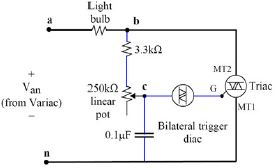
dimmer circuit puzzle

The refrigerator turned on, causing the lights to brighten. Initially, it seemed like an illusion, but after observing multiple cycles, the phenomenon persisted. When the microwave was activated, the lights dimmed. The refrigerator's operation appeared to influence the brightness of the lights. This situation raises an intriguing two-part question: first, why is a dimmer switch set to low so sensitive to minor fluctuations in line voltage; and second, what explains the unusual occurrence of the lights becoming brighter?
The scenario described involves the interaction between household appliances and their effect on electrical circuits, particularly focusing on how dimmer switches respond to changes in line voltage. When the refrigerator compressor starts, it draws a significant amount of current, which can cause a temporary voltage drop in the circuit. However, if the circuit is designed with a dimmer switch, the response to these fluctuations can lead to unexpected results.
1. **Dimmer Switch Sensitivity**: Dimmer switches often utilize electronic components such as TRIACs or MOSFETs to regulate the voltage supplied to lighting fixtures. When set to a low level, these devices can become highly sensitive to changes in line voltage. A slight increase in voltage due to the refrigerator's startup could lead the dimmer to adjust the output, resulting in a perceptible increase in brightness. This sensitivity can be attributed to the design of the dimmer circuitry, which may not be well-calibrated for the range of voltages experienced during the operation of high-demand appliances.
2. **Anomalous Brightness**: The phenomenon of lights brightening when the refrigerator operates may also be influenced by the characteristics of the electrical supply. The initial surge of current when the refrigerator turns on can create a temporary spike in voltage, particularly if the wiring is not adequately sized for the load. This spike can momentarily increase the voltage at the dimmer switch, causing it to allow more current to flow to the lights. Additionally, if the dimmer is not equipped with a proper load detection mechanism, it may misinterpret the voltage spike as a signal to increase brightness.
In summary, the interaction between the refrigerator and the lighting circuit highlights the complexities of household electrical systems. Understanding these dynamics can lead to better design choices in circuit components, ensuring stability and predictability in household lighting. Proper sizing of wiring, selection of appliances, and the use of advanced dimmer technology can mitigate such anomalies, providing a more consistent lighting experience.The fridge cut in and the lights got brighter. I thought we were imagining it but we watched for several cycles, and it kept happening. Then we tried turning on the microwave, and the lights got dimmer. But the fridge definitely made it get brighter. I think I figured out what is going on, and the answer is kind of interesting. It`s really a two-part question: part 1 is just why is a dimmer switch turned down low so very sensitive to small changes in line voltage; and part 2, why the anomalous result of the lights getting brighter 🔗 External reference
The scenario described involves the interaction between household appliances and their effect on electrical circuits, particularly focusing on how dimmer switches respond to changes in line voltage. When the refrigerator compressor starts, it draws a significant amount of current, which can cause a temporary voltage drop in the circuit. However, if the circuit is designed with a dimmer switch, the response to these fluctuations can lead to unexpected results.
1. **Dimmer Switch Sensitivity**: Dimmer switches often utilize electronic components such as TRIACs or MOSFETs to regulate the voltage supplied to lighting fixtures. When set to a low level, these devices can become highly sensitive to changes in line voltage. A slight increase in voltage due to the refrigerator's startup could lead the dimmer to adjust the output, resulting in a perceptible increase in brightness. This sensitivity can be attributed to the design of the dimmer circuitry, which may not be well-calibrated for the range of voltages experienced during the operation of high-demand appliances.
2. **Anomalous Brightness**: The phenomenon of lights brightening when the refrigerator operates may also be influenced by the characteristics of the electrical supply. The initial surge of current when the refrigerator turns on can create a temporary spike in voltage, particularly if the wiring is not adequately sized for the load. This spike can momentarily increase the voltage at the dimmer switch, causing it to allow more current to flow to the lights. Additionally, if the dimmer is not equipped with a proper load detection mechanism, it may misinterpret the voltage spike as a signal to increase brightness.
In summary, the interaction between the refrigerator and the lighting circuit highlights the complexities of household electrical systems. Understanding these dynamics can lead to better design choices in circuit components, ensuring stability and predictability in household lighting. Proper sizing of wiring, selection of appliances, and the use of advanced dimmer technology can mitigate such anomalies, providing a more consistent lighting experience.The fridge cut in and the lights got brighter. I thought we were imagining it but we watched for several cycles, and it kept happening. Then we tried turning on the microwave, and the lights got dimmer. But the fridge definitely made it get brighter. I think I figured out what is going on, and the answer is kind of interesting. It`s really a two-part question: part 1 is just why is a dimmer switch turned down low so very sensitive to small changes in line voltage; and part 2, why the anomalous result of the lights getting brighter 🔗 External reference





